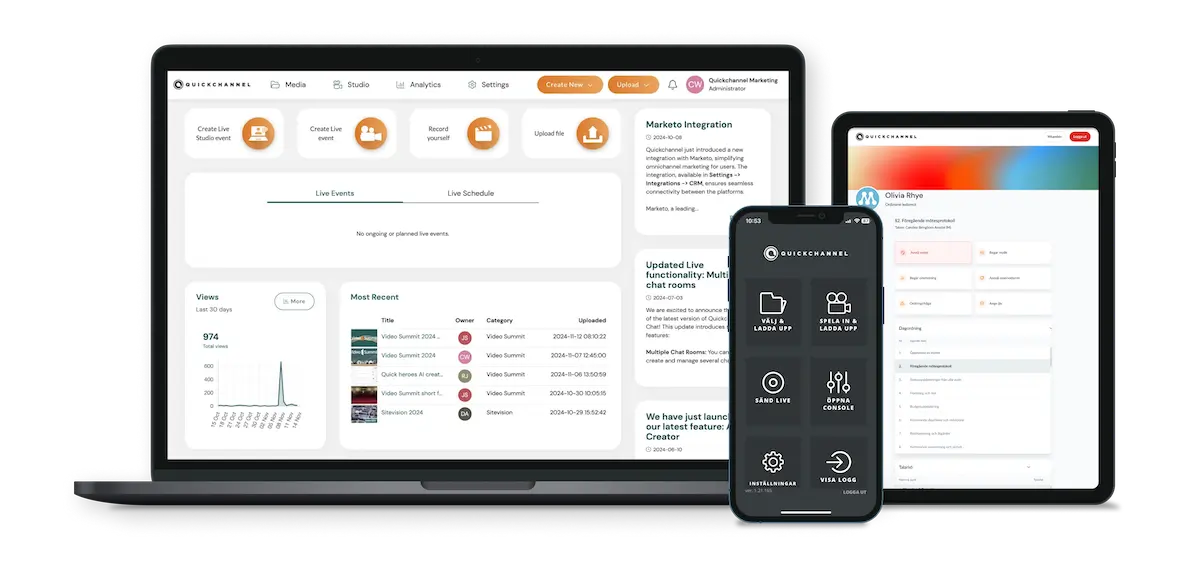quickchannel on-premises
Cloud vs On-Premises Video Platform: What’s right for your organisation?
In the world of video delivery, choosing where to host your content, cloud or on-premises, can make or break your security demands. Let’s walk through what each option offers (and costs) so you can decide with confidence.
What we mean by video hosting
Video hosting means delivering video content over the internet continuously, so viewers don’t need to download full files first. It’s everywhere now, in e-learning, webinars, internal communications, marketing, sales, and more. To make it happen, you need hosting infrastructure that can store, process (e.g. transcode), and deliver video to your audience reliably.
On this page we will break down the differences between Cloud vs On-premises (on-prem) videohosting.
Why customer choose Quickchannel, regardless of cloud or on-prem solution:
End-to-end Video Platform
With Quickchannel, you can easily manage the entire video workflow —live or on-demand—all in one video platform.
Comprehensive security, compliance and accessibility
Quickchannel is designed with stringent compliance needs in mind, offering our cloud customers GDPR compliance with customizable data residency options (EU-only or global delivery), WCAG 2.2 AA accessibility compliance for both cloud and on-prem customers, and in-house product development to ensure data security.
Local customer support and success manager
Quickchannel offers tailored local Nordic support and Customer Success Managers including onboarding to ensure organizations get personal and regionally adapted assistance.

Option 1: Cloud Video Hosting
Cloud video hosting means that you outsource the service of video storage, transcoding, delivery, and infrastructure to a cloud provider. They manage the heavy lifting; you manage your content.
Advantages of cloud hosting:
- Continuous development: Bi-weekly updates with consistent product development with at least always the latest and greatest updates.
- Scalability & flexibility: Scale up (or down) on demand. Sudden spikes in viewership aren’t a crisis; cloud providers already have the capacity built in.
- Reduced overhead: No hardware purchases, no datacenter cooling, no physical maintenance.
- Managed expertise: The provider handles upgrades, patches, and infrastructure maintenance, with less burden on your team.
- Global reach & redundancy: Cloud providers often have a distributed, fault-tolerant network that helps maintain uptime and performance.
- Pay-as-you-go costs: You pay for your license, bandwidth, storage, and compute as you use them, ideal for fluctuating demand
Things to keep in mind about cloud:
- Ongoing costs: While upfront costs are low, your monthly bill can rise with high usage. However, cloud will always be much cheaper than on-prem solutions.
- Less direct control: You may have limited access or customization of the backend infrastructure.
- Vendor lock-in risk: Migrating providers later can be cumbersome, but much easier than from on-prem solutions.
- Security & compliance dependencies: You rely partly on the provider’s security posture—critical if your content has strict regulatory concerns.
Option 2: On-prem video hosting
On-prem video hosting is when you host and manage video infrastructure in your own data center or private facility. You own the servers, the network, and the whole stack.
Advantages of on-prem video hosting
- Full control: We (as in the video platform provider) set minimum requirements; you decide everything else—from hardware specs to network architecture to security policies
- Predictable long-term costs based on license: After the initial investment, your usage cost will be handled by your infrastructure.
- Compliance & security assurance: For regulated industries (e.g. healthcare, government), having direct control over data paths, the possibility to run it air-gapped and physical infrastructure can be crucial.
Things to keep in mind about on-prem
- High upfront Investment: You must budget for servers, networking gear, space, cooling, power, and software licenses etc.
- Maintenance of burden: Hardware fails. You’ll need ops staff, in-house competence to maintain and upgrade and regular replacement cycles.
- Scaling Challenges: To grow capacity, you need to plan, purchase, and deploy new hardware—slow and expensive.
- Redundancy Complexity: Building failover, backups, disaster recovery all require additional investment and ongoing effort.

Cost comparison: Cloud vs On-premises for Video Hosting
Here’s a breakdown of how cost stack up across the two options and categories:
| Cost category | Cloud video hosting | On-premises video hosting |
|---|---|---|
| Hardware | None — provider owns it. | You buy, maintain, replace |
| Setup & Deployment | Typically fast / automated | Manual installation, configuration and updates |
| Uptime / SLAs | Providers usually offer strong SLAs | You’re responsible for your own reliability |
| Scaling | Easy, elastic scaling | Requires new hardware and upfront costs which leads to over/underutilization |
| Support & Maintenance | Included (some level) | You handle first line support and maintenance |
| Personnel | No in-house infrastructure staff needed | In-house staff to manage the infrastructure |
| Backup & Disaster Recovery | Always built-in with cloud plans | You must design and manage backup / disaster recovery yourself |
| Operational Expenses | Predictable recurring costs | Utilities, physical security, cooling, etc. |
Summary
In many cases, cloud hosting shines for organizations starting out or needing flexibility. Choosing on-premise is always driven by security or control, never by cost control. On-prem is more expensive, not just licensing it, but also all the other costs and hardware needed.
Deciding what’s best for your organisation
Here’s a quick decision guide:
- If you want to move fast, scale dynamically, and avoid heavy capital investments, cloud hosting is likely your best choice.
- If your use case demands tight control, strict compliance and you have the infrastructure and staff to support it, on-premises hosting may be worth the investment.
Whatever path you choose, make sure your priorities—security, reliability, performance, and scalability—are non-negotiable in your evaluation.
Why Quickchannel
Quickchannel is a European-based video company, offering a complete video platform for businesses. We’ve been around for more than 20+ years in video software market and are trusted by the most strict governments in the Nordics.
Our video platform supports everything from live streaming and webinars to brand customization and video editing. Quickchannel makes it easy for users to plan, stream, record, and edit high-quality videos directly in the browser. All content can be stored securely on Quickchannel’s fully GDPR-compliant videosite, allowing organizations to efficiently manage, organize, and publish their video content.
Our customers range from large enterprises such as Saab, Dagens Nyheter (largest morning Newspaper in Sweden), Skanska, Swedbank and DNB to public sector authorities like the Swedish Public Employment Service (Arbetsförmedlingen), several Finnish Wellbeing States (Regions) and the Norwegian Government to name a few.

Why customers choose Quickchannel
Probably the most compliant video platform on the market
Quickchannel ensures robust security, GDPR compliance, and adherence to WCAG accessibility standards, making it a trusted video platform for both public and private sector organizations.
End-to-End Data Protection
Your data is safeguarded at every stage – from hosting, recording to publishing.
GDPR compliance
Fully GDPR compliant with global privacy standards for your peace of mind.
Accessibility & WCAG compliance
We are committed to accessibility and ensure that our end-user-facing components — including our player and Videosite — meet WCAG 2.2 AA standards. In addition, we also comply with most of the AAA guidelines.
FREQUENTLY ASKED QUESTIONS ABOUT CLOUD VS ON-PREM VIDEO HOSTING
Get answers to your questions.
What’s the main difference between cloud and on-premises video hosting?
Cloud: Your videos live on servers managed by a third-party provider. You pay for storage, bandwidth, and processing as you go.
On-Premises: Your organization owns and manages the servers and infrastructure. We deliver the packages you need; you install them on your premises.
Which is more cost-effective?
Cloud: Lower upfront costs, predictable monthly bills, but long-term expenses can grow as usage scales.
On-Premises: High upfront investment (servers, cooling, power, staff) and a predicable license fee. On-premises are always driven by security or control, never by cost control.
Which option is easier to scale?
Cloud: Instantly elastic—if you suddenly need to serve thousands of viewers, the cloud can scale up seamlessly.
On-Premises: Scaling requires buying and installing new hardware, which is slower and more capital-intensive.
Which is better for security and compliance?
A top cloud provider offer strong security standards, encryption, and compliance certifications. But you must trust their processes. Learn how we handle video security here.
On-Premises: Gives you full control over security policies and compliance—important for sectors like finance, healthcare, or government.
What about reliability and uptime?
Cloud: Providers often guarantee uptime with SLAs and offer global redundancy.
On-Premises: Reliability depends on your internal setup. Building redundancies (backups, failover systems) is possible but costly.
Do I need a large IT team?
Cloud: Minimal IT involvement—most of the infrastructure is managed for you.
On-Premises: Requires a skilled IT/DevOps team to maintain, troubleshoot, configure and upgrade servers.
Which is faster to get started with?
Cloud: Typically ready in minutes or hours.
On-Premises: Can take weeks or months to install, configure, and optimize.On-Premises: Requires a skilled IT/DevOps team to maintain, troubleshoot, configure and upgrade servers.
Is there a risk of being “locked in” with cloud providers?
Yes. Migrating large volumes of video data from one cloud vendor to another can be complex and expensive. It is more difficult to migrate from on-prem. The cost will be higher, and new vendors can’t help if it’s an air-gapped or locked down environment, meaning the customer must do the migration themselves.
What about global reach?
Cloud: Providers often have distributed data centers worldwide, ensuring low latency and smooth playback for international audiences.
On-Premises: No, this is not an option for on-premises.
Which is right for me?
Choose Cloud if you need flexibility, fast deployment, and global scale without heavy upfront investments.
Choose On-Premises if compliance, control, or custom integrations are non-negotiable—and if you’re prepared for the costs and maintenance.
How do I get started with Quickchannel?
Simply fill out the form on this page to book a demo with one of our experts and we’ll help you figure out your needs.
Compare Quickchannel vs:
Quickchannel vs Dream Broker
Quickchannel vs Microsoft Teams Town Hall
Quickchannel vs Vimeo
Quickchannel vs Brightcove
Your video partner here and beyond
Our mission is to revolutionize working with video through innovative functionality and efficient workflows, integrated in the customers’ eco system.
300+
customers in Europe
29+ years
in the market
#1
video platform on the Swedish market
















